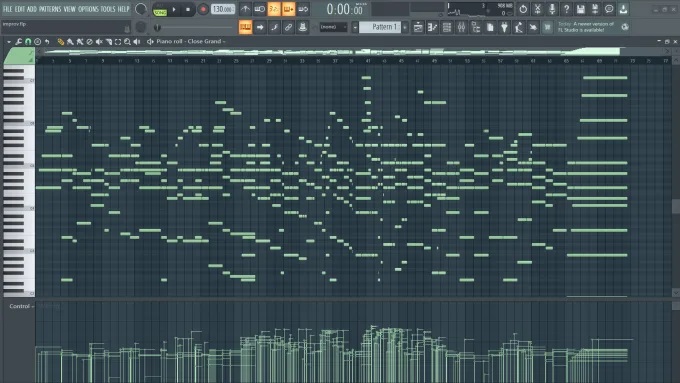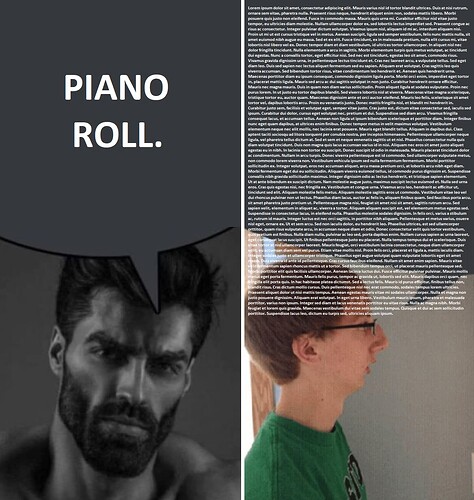I used pirated FL when I first started as a teen, knew how to read music, and understood the concept of “player pianos” so I was off to the races pretty fast. I programmed some technical drum stuff with the PR but the more I got into that the more tedious it got.
Probably a year after I started with FL I saw that venetian snares video of Vasch and had to try. Probably because I was still young (impressionable) and familiar with several notation systems, renoise did not take long to pick up on (though I also simply HAD to know how it worked, so I can’t discount the significance of that teenage-drive in learning).
I have been to many corners of the musical sphere, and I have dragged my feet at times with insisting to use certain tools (traditional staff notation, midi files) for what is probably not their best task.
For instance, for someone learning about jazz but not interested in becoming a capable jazz-player, I think that conventional lead-sheet chord nomenclature is like…the absolute worst way to gain any comprehension of the medium/large-scale harmonic structure of a piece. It just takes the human eye a lot of work to start seeing ii-V’s, and then larger cadence structures, when it’s just a sea of letters and numbers. Compare that to a schenker graph – which, reciprocally, is probably the worst way you could ever learn to realize the surface-details of a composition – this is a graphical system meant to reveal medium/large-scale harmonic structure.
So anyways: I slept on the piano roll tools in renoise (I use simple piano roll when needed, at present) for a long time, until I realized that – in similar terms to my comparison above – renoise simply gives you no immediate sense of pitch-contour, because your eye sees first the pitch-class (chromatic pitch name) and then the octave (which may not even correspond to the fundamental pitch the instrument is playing, depending on instrument settings), and then your brain kind of has to reconstruct the octave-break being at C (because imho it would be easier on the human mind if it were at A, but we’re a few hundred years too deep in that hole, so).
Whatever this particular example is (and indeed I would not have an easy time trying to hum-out the melodies here without doing a lot of referring back and forth to the vertically arranged piano keys), I can see that it’s probably a reasonably good arrangement based on contour alone. One can see that there is overall good voice leading (which can matter more or less depending on style or instrumentation, granted), and beyond voice leading it’s probably a decent section of music overall, judging by the kind of climaxy-part in the middle, which is supported by a change of rhythm and melodic direction, for instance. The velocity values give me agita, but even there you can see that the overall intensity builds around that moment, to support what is happening harmonically. There’s a kind of hierarchy of information here that is very different in a tracker view, which I think most people know is truly superior in super-detailed sample manipulation work, and is often preferable for music that is more oriented towards rhythm rather than harmonic structures that go beyond verse-chorus level (nothing wrong with that). Of course, you absolutely can develop the ability to “see” these things in the tracker view, but imho it still takes conscious effort to basically reconstruct mentally what you would just be looking at in a piano roll view. And I am all about using technology to handle the mental workload, when it’s trivial.
Anyway, reason I’m throwing my 2 cents in is because going back to using piano rolls in renoise when needed has been very helpful for me when I want to take a more harmonically involved compositional approach. If something “isn’t working” hopefully my ear will be good enough to tell what is off, and it is then not hard to find the moment in the pattern-editor. However, just as one can get ear-fatigue with mixing, I think you can experience a kind of mental fatigue when working inappropriately on compositional/arrangement aspects of the music. (I say inappropriate because I think this can be avoided just as skillfully as ear-fatigue)
And for me personally, one way I get out of those unhelpful ruts-of-thought is to quickly jump to the piano roll and look at the phrase that I’m working on. Sometimes, I will see what should have been obvious, like I’m using monotonous (unpleasant) repetitions of sequences of notes that draw attention away from the overall intended movement of the line. It’s usually pretty easy to “see” bad voice leading (again, when that matters), and I don’t know any notation standard that does this as well (including standard staff-notation, because the line-weighting between different entities often does not correspond at all to their musical significance…it’s just a compromise that is probably close to optimized for composers, performers, and analysts – taken altogether. Anyway)
We can all agree (on objective reality…I hope) that the actual information (besides tracker-style pattern fx) being visualized in a (modern-daw-)tracker view and a piano roll is the same in both cases. I’m throwing this in as a means of encouraging those who would like to think of ways that you can expand your inventory of approaches. If what you do works for you, then obviously don’t fw it.
And yes, the tracker view works better within renoise, in general, because the software has been set up as a tracker from the beginning. Daps to Taktik for having integrity on the matter. I simply don’t see what a native piano roll has to offer that would not effect all sorts of things (development speed alone…most of us just don’t want a native piano roll out of a desire not to have bloat, and that’s a lot of development time for something that has always been expressly out of the scope for the project). I appreciate his clarity on the matter, and it would be nice if the conversation could be different between us users. Idk…maybe the joke is still really that funny to some of you (~16 years). You cats need to say the serenity prayer or something hahaha.

